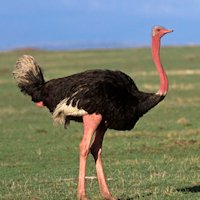
|
Some Common Myths Thought to be True - Myth 45
Myth 45: Ostriches Hide their Heads in the Sand
Ostriches do not hide their heads in the sand to hide from enemies. This
misconception was probably promulgated by Pliny the Elder (AD 23-79), who wrote
that ostriches "imagine, when they have thrust their head and neck into a bush,
that the whole of their body is concealed." This may have been a
misunderstanding of their sticking their heads in the sand to swallow sand and
pebbles, or, as National Geographic suggests, of the defensive behavior of
lying low, so that they may appear from a distance to have their head buried.
|
| Ostrich | |
|
The ostrich's diet consists mainly of plant matter, though it also eats
invertebrates. It lives in nomadic groups of 5 to 50 birds. When threatened,
the ostrich will either hide itself by lying flat against the ground, or run
away. If cornered, it can attack with a kick of its powerful legs. Mating
patterns differ by geographical region, but territorial males fight for a harem
of two to seven females.
|
|
| ⇦ Back to Myth 44 Return to Myth Choices Page 4 On to Myth 46 ⇨ | |